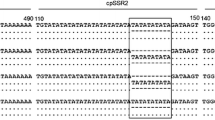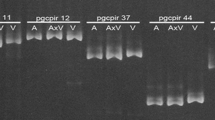Summary
Chromosome behaviour at meiosis, isozyme studies and analysis of the chloroplast DNA restriction fragments were used to assess the phylogenetic relations among the three Papaver species of the section Oxytona. The multivalents observed in diplotene — diakinesis stages of meiosis of the hexaploid P. pseudo-orientale and its tetraploid hybrid with P. bracteatum indicate the autopolyploid nature of this section. Further evidence supporting this conclusion was obtained from isozyme analysis. The same number of isozymes was expressed in all the species regardless of their ploidy level. Inheritance studies conducted with Pgi, Dia and Acp allozymes demonstrated, for the first time, the transfer and expression of genetic material among these species. The differences found in the chloroplast DNA restriction fragments of the Oxytona species and of P. somniferum indicate intensive evolution of the chloroplast DNA in the genus Papaver. The similarity of the chloroplast DNA restriction patterns and of the isozymes in P. orientale and P. pseudo-orientale suggested that P. orientale was the female parent in the cross generating P. pseudo-orientale and that the latter species is of recent origin.
Similar content being viewed by others
References
Cauderon Y (1985) Cytogenetics in breeding programs dealing with polyploidy, interspecific hybridization and introgression. In: Horn W, Jeisen CJ, Odenbach W, Schieder O (eds) Proc Int Symp Eucarpia, Berlin
Chyi YS, Weeden NE (1984) Relative isozyme band intensities permit the identification of the 2n gamete parent of triploid apple cultivars. HortScience 19:818–819
Crawford DJ (1983) Phylogenetic and systematic inferences from electrophoretic studies. In: Tanksley SD, Orton TJ (eds) Isozymes in plant genetics and breeding. Elsevier, Amsterdam, pp 257–287
Desborough SL (1983) Potato (Solanum tuberosum L.). In: Tanksley SD, Orton TJ (eds) Isozymes in plant genetics and breeding, part B. Elsevier, Amsterdam, pp 167–188
Ferris SD, Whitt GS (1977) Loss of duplicate gene expression after polyploidisation. Nature, London 265:258–260
Goldblatt P (1974) Biosystematic studies in Papaver section Oxytona. Ann Mo Bot Gard 61:264–296
Gottlieb LD (1981 a) Electrophoretic evidence and plant populations. Prog Phytochem 7:1–46
Gottlieb LD (1981 b) Gene number in species of Astereos that have different chromosome numbers. Proc Natl Acad Sci USA 78:3726–3729
Hart GE (1983) Hexaploid wheat. In: Tanksley SD, Orton TJ (eds) Isozymes in plant genetics and breeding, part B, Elsevier, Amsterdam, pp 35–56
Hosoka K (1986) Who is the mother of the potato? Restriction endonuclease analysis of chloroplast DNA of cultivated potatoes. Theor Appl Genet 72:606–618
Li WH (1980) Rate of gene silencing at duplicated loci: a theoretical study and interpretation of data from tetraploid fishes. Genetics 95:237–258
Milo J, Levy A, Ladizinsky G, Palevitch D (1986) Phylogenetic studies in Papaver section Oxytona: cytogenetics of the species and interspecific hybrids. Theor Appl Genet 72:524–529
Palmer JD, Shields CR, Cohen DB, Orton TJ (1983) Chloroplast DNA evolution and the origin of amphidiploid Brassica species. Theor Appl Genet 65:181–189
Palmer JD, Zamir D (1982) Chloroplast DNA evolution and phylogenetic relationships in Lycopersicon. Proc Natl Acad Sci USA 79:5006–5010
Roose ML, Gottlieb LD (1976) Genetic and biochemical consequences of polyploidy in Tragopogon. Evolution 30:818–830
Saltz Y, Beckman J (1981) Chloroplast DNA preparation from Petunia and Nicotiana. PMB Newslett 2:73–74
Sheen SJ (1972) Isozymic evidence bearing on the origin of Nicotiana tabacum L. Evolution 26:143–154
Tanksley SD (1979) Linkage, chromosomal association and expression of Adh-1 and Pgm-2 in tomato. Biochem Genet 17:1159–1167
Theuns HG, Janssen RHAM, Salemink CA (1987) The alkaloids of the Papaver section Oxytona Bernh. Herbs, spices and medicinal plants. Recent Adv ot Hort Pharm 2:57–110
Vallejos CE (1983) Enzyme activity staining. In: Tanksley SD, Orton TJ (eds) Isozymes in plant genetics and breeding. Elsevier, Amsterdam, pp 469–516
Vedel F, Quetier F, Cauderon Y, Dosba F, Doussinault G (1981) Studies on maternal inheritance in polyploid wheats with cytoplasmic DNAs as genetic markers. Theor Appl Genet 59:239–245
Weeden NF (1983) Evolution of plant isozymes. In: Tanksley SD, Orton TJ (eds) Isozymes in plant genetics and breeding. Elsevier, Amsterdam, pp 175–205
Zamir D, Ladizinsky G (1984) Genetics of allozyme variants and linkage groups in lentil. Euphytica 33:329–336
Author information
Authors and Affiliations
Additional information
Communicated by H.F. Linskens
Contribution no. 2199 —E, 1987 series from the Agricultural Research Organization, The Volcani center, Bet Dagan 50 250, Israel
Rights and permissions
About this article
Cite this article
Milo, J., Levy, A., Ladizinsky, G. et al. Phylogenetic and genetic studies in Papaver section Oxytona: cytogenetics, isozyme analysis and chloroplast DNA variation. Theoret. Appl. Genetics 75, 795–802 (1988). https://doi.org/10.1007/BF00265607
Received:
Accepted:
Issue Date:
DOI: https://doi.org/10.1007/BF00265607




